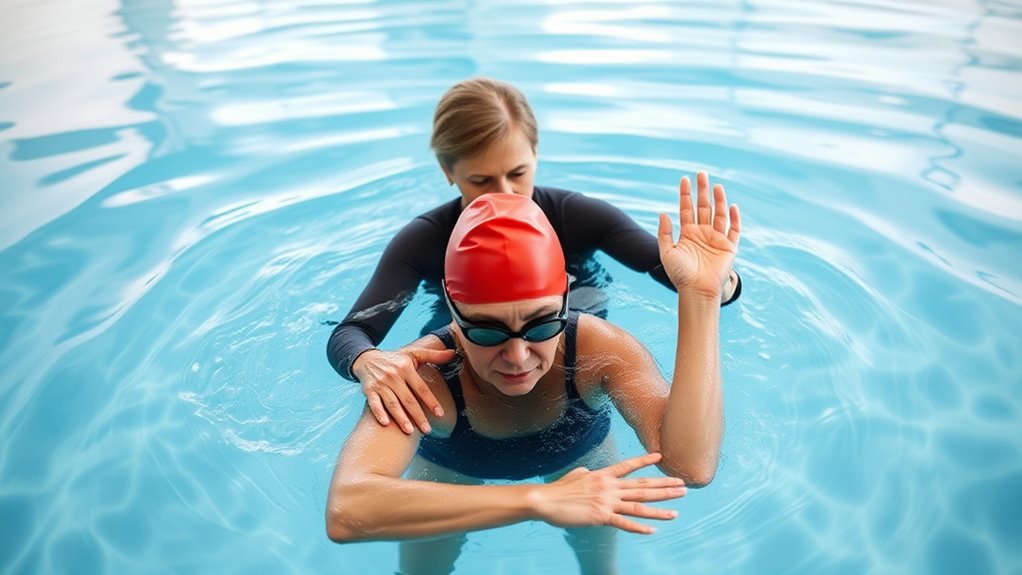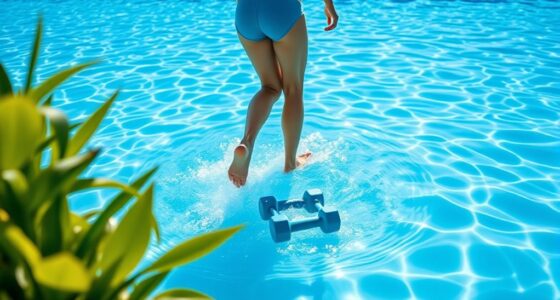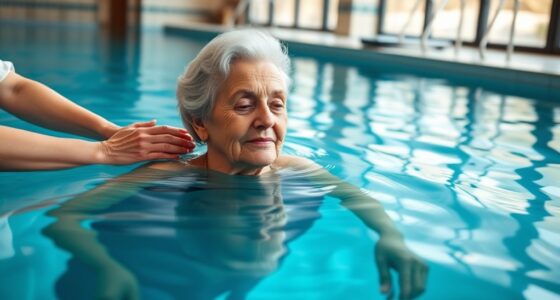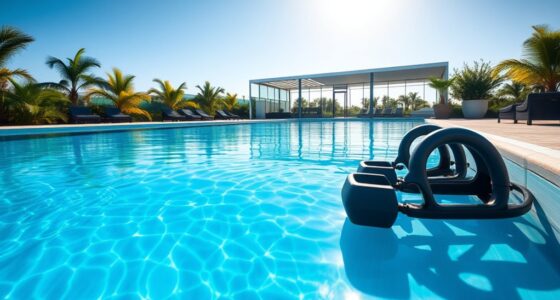Aquatic physical therapy uses water’s natural resistance, buoyancy, and temperature to support your recovery. The resistance helps you build strength safely, while buoyancy reduces impact on your joints and muscles, making movement easier and less painful. Warm water relaxes muscles and eases stiffness, enhancing your therapy sessions. This combination allows you to perform exercises that might be difficult or impossible on land, speeding up healing and improving mobility—exploring these techniques reveals even more ways water can help your recovery.
Key Takeaways
- Aquatic therapy uses water’s resistance to enhance muscle strengthening and improve endurance safely.
- Buoyancy reduces joint and muscle load, allowing pain-free movement and increased range of motion.
- Water’s natural support eases pain and facilitates gentle exercises during recovery.
- Combined resistance and buoyancy promote faster healing and safe progression in flexibility and strength.
- Water temperature optimizes relaxation, reduces stiffness, and enhances overall therapeutic outcomes.

Have you ever considered how water can aid in recovery and improve movement? When you immerse yourself in water during therapy, you’re tapping into the unique properties of this medium to enhance your healing process. One of the key benefits is water resistance, which provides a gentle yet firm force against your movements. Unlike traditional exercises on land, where gravity can make certain motions painful or difficult, water resistance allows you to work your muscles without overexertion. It creates a natural form of resistance that you can adjust simply by changing your speed or the area of your body in contact with the water. This means you get a customized workout that promotes strength and endurance without risking further injury.
Another vital aspect is the buoyancy effects of water. Buoyancy acts as a natural support system, reducing the weight your joints and muscles have to bear. When you’re immersed, you might feel like you’re floating, which considerably decreases the impact on painful or injured areas. This reduced load allows you to perform movements that would otherwise be too painful or impossible on land, making it easier to regain mobility and flexibility. The buoyancy also encourages a greater range of motion, helping you stretch and strengthen muscles safely. Because of this supportive environment, you can push yourself a little further than you might in traditional therapy, knowing that the water will cushion your movements and minimize discomfort. Incorporating water temperature can also optimize relaxation and muscle recovery during aquatic therapy sessions.
These water properties work together to create an environment that promotes faster, safer recovery. The resistance challenges your muscles in a controlled manner, helping to rebuild strength gradually, while buoyancy reduces strain, enabling you to perform exercises that improve flexibility and joint mobility. This combination is especially beneficial for those recovering from surgery, managing chronic conditions, or dealing with injuries that make weight-bearing exercises painful. As you engage in aquatic therapy, you’ll likely notice that movements feel easier and less painful, boosting your confidence and motivation to keep progressing.
Frequently Asked Questions
Can Aquatic Therapy Help With Chronic Arthritis Pain?
You might wonder if aquatic therapy can ease your chronic arthritis pain. The good news is, it can substantially help with arthritis relief and pain management. Water’s buoyancy reduces joint stress, allowing you to move more freely and comfortably. Regular sessions can improve your flexibility, strength, and reduce stiffness, making daily activities easier. So, if you’re seeking a gentle, effective way to manage your arthritis pain, aquatic therapy could be a great option for you.
How Often Should I Attend Aquatic Therapy Sessions?
Think of your therapy journey as planting a seed—you need consistent care to see it grow. For ideal results, you should discuss your session frequency and treatment duration with your therapist, who will tailor the plan to your needs. Typically, attending 1-3 sessions per week helps maintain progress. Remember, regular attendance nurtures recovery, so sticking to your schedule ensures steady improvement and a smoother path to relief.
Are There Any Risks or Contraindications for Aquatic Therapy?
You might wonder if aquatic therapy has risks. Generally, it’s safe, but watch out for water temperature—if it’s too cold or warm, it could cause discomfort or health issues. Also, there’s an infection risk if the pool isn’t properly sanitized. Always inform your therapist of any skin conditions or open wounds, so they can guarantee safety and minimize risks during your sessions.
What Equipment Is Used During Aquatic Physical Therapy?
Did you know that over 80% of aquatic therapy sessions utilize specialized equipment? During therapy, you’ll use items like pool buoyancy devices to support your body and resistance bands to enhance muscle strength. These tools make exercises safer and more effective by leveraging pool buoyancy for reduced joint stress and resistance bands for targeted strengthening, helping you recover faster with less pain.
Can Children Benefit From Aquatic Therapy?
You might wonder if children can benefit from aquatic therapy. The answer is yes, and it often improves therapy outcomes markedly. With proper precautions, such as ensuring child safety measures, aquatic therapy creates a safe environment for kids to strengthen muscles, improve coordination, and increase flexibility. Children respond well to water-based exercises, making this a valuable option for their physical development and recovery.
Conclusion
Aquatic physical therapy is like a gentle wave that carries you toward recovery, making movement easier and less painful. By embracing these techniques, you’ll find renewed strength and flexibility, helping you return to your daily activities with confidence. Just as water supports and cushions, it offers a safe environment to push past limits and heal. Immerse yourself in aquatic therapy, and let it be the tide that lifts you to better health and well-being.









